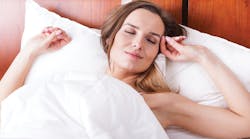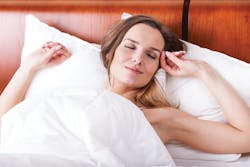Here’s a question you may not have asked lately. How many men, women, and children under your care have undiagnosed sleep-disordered breathing (SDB) issues? I believe this topic warrants more attention from dental professionals, so I’d like to share what I learned about SDB from personal experience. I bet some of you reading this are just like me, and more importantly, you see a lot patients who are like me.
My learning experience began one morning when my husband said, “Karen, you were snoring last night.”
I quickly replied, “No, I wasn’t.” I don’t snore!
After we bantered for a few minutes, I conceded. I asked, “Well, was the snoring at least quiet and feminine?” When he said no, I had to pick up my jaw off the floor. I couldn’t believe it. He was the one with sleep apnea. He wore the CPAP every night.
What would my snoring mean for me? I was curious enough to take the next step, so I downloaded an app called SnoreLab. I now recommend this app to my patients so they can find out whether or not they snore. Not all snoring indicates sleep apnea. But if you do snore you need to find out whether or not you stop breathing for 10 seconds or more during these events referred to as sleep apnea. Breathing cessation, even for a few seconds at a time, reduces the oxygen traveling to cells and organs, which contributes to a domino effect that adversely impacts health.
What did I learn from my SnoreLab app when it recorded my snoring, and then ranked the snoring episodes as quiet, light, loud, or epic? Again, I had to pick up my jaw off the floor when I checked it. I made it all the way up to epic snoring! Definitely not feminine. Mind you, I was completely unaware that somehow my sleep had turned into a snoring frenzy.
Next I wanted to learn whether or not my snoring was associated with obstructive sleep apnea (OSA). I didn’t think so because I did not have the daytime fatigue that’s often associated with sleep apnea. But I knew I needed a sleep study to find out. I did a home sleep study, just like the one I recommend to my patients who have symptoms of SDB or OSA. It was easy, and the results were fast. Much to my surprise, I was diagnosed with mild to moderate sleep apnea.
Who suffers from sleep issues?
SDB includes people who have sleep apnea and upper-airway resistance syndrome (UARS), hallmarked by restricted breathing, daytime sleepiness, and insomnia The bottom line for all of these airway issues is that sleep is not restful due to frequent waking, poor quality sleep, and lack of oxygen. It’s no surprise that our patients who are overweight, over the age of 50, or have a large neck and waist circumference also have some degree of OSA. They fit the profile.
So it might surprise you to learn that some children have sleep apnea, some young and thin women have sleep apnea or UARS, and some physically fit men have sleep apnea. It is estimated that 26 million people suffer from sleep apnea. Twenty-six percent of people ages 30 to 70 have mild to moderate SDB, and about 10% have moderate to severe SDB.1
Estimates on deaths related to OSA are hard to quantify because of comorbidities associated with OSA, but current estimates are that about 38,000 die annually from cardiovascular-related OSA.1 If you are not currently screening patients for sleep-disordered breathing, an effective tool is the Epworth Sleepiness Scale. View a sample at http://yoursleep.aasmnet.org/pdf/Epworth.pdf.
At this point, I want you to think about your patient base. Sadly, only 15% of people with airway problems are diagnosed. How many patients in your care suffer from airway issues and have not been diagnosed or offered a solution?
A great service is to provide a home sleep study device for your patients. It is not cumbersome and results are available quickly. Refer patients with severe OSA for assessment in a sleep laboratory to collect more detailed information, as indicated. Joining the American Academy of Physiological Medicine and Dentistry (aapmd.org) is a worthwhile investment, as it provides up-to-date webinars on a wide array of topics about sleep-disordered breathing for dental and medical professionals.
If you want to learn more about the risk factors that contribute to SDB, what can be done to prevent it, and how best to treat it, I recommend the book Gasp, by Michael Gelb, DDS, and Howard Hindin, DDS. Their intent was to publish a book that could be read and digested by laypeople, but even as a dental professional I learned a lot from their book. As a result, I’m better able to assess patients for risk factors, discuss the implications of SDB, and guide patients toward appropriate diagnosis and screening tools.
What is my sleep pattern like today? I’m having sweet dreams and no apnea issues, thanks to a proper diagnosis and a mandibular advancement device that I wear each night. Your patients may not fit the profile for snoring, and many are completely unaware that they snore. But you don’t have to be an expert on this topic to make a difference. Start by assessing and screening your patients for SDB, and don’t forget to start with yourself!
Reference
1. Peppard PE, Young T, Barnet JH, Palta M, Hagen EW, Hla KM. Increased prevalence of sleep disordered breathing in adults. American Journal of Epidemiology 2013; 177(9):1006-1014
Karen Davis,BSDH, RDH, is the founder of Cutting Edge Concepts, an international continuing education company, and practices dental hygiene in Dallas, Texas. She is an independent consultant to the Philips Corp., Periosciences, and Hu-Friedy/EMS. She can be reached at k[email protected].







